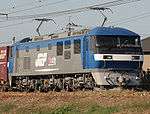JNR Class EF66
|
EF66 11 | |||||||||||||||||||||||||
| |||||||||||||||||||||||||
| |||||||||||||||||||||||||
| |||||||||||||||||||||||||
| |||||||||||||||||||||||||
The Class EF66 (EF66形) is a 6-axle, 3-bogied (Bo-Bo-Bo) DC electric locomotive designed for fast freight used by Japanese National Railways (JNR) and currently operated by its descendents JR West and JR Freight.[1]
Background and history

Originally these locomotives were designed for express freight on the Tokaido Main Line and Sanyo Main Line, in an attempt to counter the increasing market share being gained by road transport, by providing a fast alternative to road transport using wagons suitable for containerised freight.
The prototype (initially numbered EF90 1, later becoming EF66 901) was built by Kawasaki Sharyō in 1966; at the time with a power of 3.9 MW it was the world's most powerful narrow-gauge locomotive.[1] The EF66 901 locomotive was retired from front-line service in 1996 and since 2001 is stored at Hiroshima Depot.
The production series of locomotives were delivered from 1968, with 55 built between 1968 and 1974.[1]
Due to increased demand, JR Freight began building more EF66s in 1989 - this second batch of locomotives was classified EF66-100, with locomotive numbered EF66-101 to EF66-133.
Technical
The locomotives were designed to be able to haul a 1,000-tonne train at 100 km/h. Each motor has a 650 kW power output, (about 50% more powerful than the EF65). The bogies have an air suspension system to limit the impulsive forces on the track.
Of the first series of production the last 35 (i.e. 21st to 55th locomotive) were slightly different in design, externally a few changes were made - most noticeably above the drivers window a slight 'ledge' is added. Internally, these locomotives had their auxiliary electrical supply uprated from 5 kW to 90 kW.
The second series of locomotives (EF66-100) are fundamentally the same design as the first, but with slightly more modern external styling. The driver's cabs are air-conditioned.
Operations
During the JNR era, these locomotives were used for freight trains and also for passenger work - primarily hauling night trains such as the Hayabusa sleeping car limited express.[2]
Following privatisation, JR Freight received the prototype (EF66 901) and 39 of the original series (EF66 1 to EF66 39) as well as the EF66-100 machines. Some refurbishment of the locomotives has taken place since. JR West obtained the remainder of the machines (EF66 40 to EF66 55) - a total of 16.
As of 1 April 2009, 73 EF66s (including all 33 EF66-100s) were in service, with 63 owned by JR Freight (all based at Suita Depot in Osaka), and 10 owned by JR West (all based at Shimonoseki Depot).[3]
 EF66 20 hauling freight cars, 1985
EF66 20 hauling freight cars, 1985 EF66 37 original build, with extended roof and air conditioning
EF66 37 original build, with extended roof and air conditioning Class EF66-100 EF66 108, December 2009
Class EF66-100 EF66 108, December 2009
Preserved examples
- EF66 1: Stored at Hiroshima Depot in Hiroshima.[4]
- EF66 11: Preserved at The Railway Museum in Saitama.[4]
- EF66 35: Preserved at the Kyoto Railway Museum in Kyoto.[5]
- EF66 45: (No. 1 end cab section) Preserved at a museum located next to Torokko Saga Station in Kyoto.[6]
- EF66 45: (No. 2 end cab section) Preserved outside the Hoshiai Eye Clinic in Midori-ku, Saitama, Saitama Prefecture.[7]
- EF66 49: (No. 1 end cab section) Preserved at a museum located next to Torokko Saga Station in Kyoto.[6]
- EF66 49: (No. 2 end cab section) Preserved at the Pain Aux Seigle bakery in Kizugawa, Kyoto, located near Kizu Station.[8]
 EF66 35 at the Kyoto Railway Museum in October 2016
EF66 35 at the Kyoto Railway Museum in October 2016- The cab end of EF66 45 in Saitama in July 2014
See also
References
| Wikimedia Commons has media related to JNR EF66. |
- 1 2 3 Fujii, Katsuhisa (November 1991), "国鉄最大最強力電機EF66形のすべて" [All about Class EF66, the largest and the most powerful electric locomotive of JNR], Japan Railfan Magazine, Japan: Koyusha Co., Ltd., vol. 31 no. 367, p. 8 et seq.
- ↑ EF66-100
- ↑ JR全車輌ハンドブック2009 [JR Rolling Stock Handbook 2009]. Japan: Neko Publishing. 2009. ISBN 978-4-7770-0836-0.
- 1 2 Sasada, Masahiro (25 November 2014). 国鉄&JR保存車大全2015-2016 [JNR & JR Preserved Rolling Stock Complete Guide 2015-2016] (in Japanese). Tokyo, Japan: Ikaros Publications Ltd. p. 122. ISBN 978-4863209282.
- ↑ 京都鉄道博物館 [Kyoto Railway Museum]. Japan Railfan Magazine (in Japanese). Vol. 56 no. 662. Japan: Koyusha Co., Ltd. June 2016. p. 47.
- 1 2 Shimizu, Kaoru (January 2011). "栄光のブルトレ牽引機EF66 45・49 新たなる任務を負って(前編)~嵯峨野への旅~" [Famous Blue Train locomotives EF66 45&49 start new duties (Part 1) The journey to Sagano]. Japan Railfan Magazine. Vol. 51 no. 597. Japan: Koyusha Co., Ltd. pp. 104–107.
- ↑ Shimizu, Kaoru (September 2014). "栄光のブルトレ牽引機EF66 45・49 新たなる任務を負って" [Famous Blue Train locomotives EF66 45&49 start new duties]. Japan Railfan Magazine. Vol. 54 no. 641. Japan: Koyusha Co., Ltd. pp. 138–139.
- ↑ "パン屋さんの店頭に49号機!" [Loco No. 49 in a Baker's!]. Japan Railfan Magazine. Vol. 51 no. 607. Japan: Koyusha Co., Ltd. November 2011. pp. 104–5.

